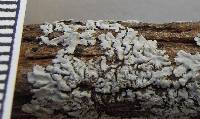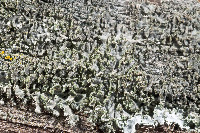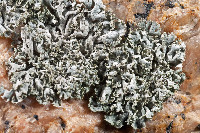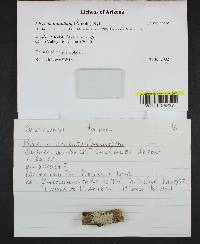
Consortium of Lichen Herbaria
- building a Global Consortium of Bryophytes and Lichens as keystones of cryptobiotic communities -
- Home
- Search
- Images
- Species Checklists
- US States: O-Z >
- US National Parks
- Central America
- South America
- US National Parks
- Southern Subpolar Region
|
|
|
|
Family: Physciaceae
[Parmelia albinea var. dimidiata (Arnold) Jatta, moreParmelia dimidiata (Arnold) Arnold, Parmelia pulverulenta var. dimidiata Arnold, Physcia aipolia var. dimidiata (Arnold) Nyl., Physcia albinea var. dimidiata (Arnold) Nyl., Physcia dimidiata f. dimidiata (Arnold) Nyl., Physcia dimidiata var. dimidiata (Arnold) Nyl., Physcia stellaris f. dimidiata (Arnold) Boistel, Physcia stellaris var. dimidiata (Arnold) Berdau] |
Nash, T.H., Ryan, B.D., Gries, C., Bungartz, F., (eds.) 2002. Lichen Flora of the Greater Sonoran Desert Region. Vol 1. Thallus: irregular, sometimes orbicular, up to 3 cm diam., with ± imbricate lobes lobes: up to 3 mm wide but usually narrower, crenulate at tips with minute lobules, eciliate upper surface: brownish gray to gray or cream colored, with a ± prominent pruina (crystals), sorediate soredia: granular, in marginal soralia, less frequent on outer lobes upper cortex: paraplectenchymatous medulla: white lower cortex: prosoplectenchymatous lower surface: whitish to brownish, with pale gray to brownish rhizines Apothecia: rare, not seen in Sonoran material, elsewhere up to 2 mm diam.; disc: white-pruinose ascospores: brown, 1-septate, Physcia-type, 17-23 x 8-12 µm Pycnidia: rare (not seen) Spot tests: upper cortex K+ yellow, C-, KC-, P+ yellow; medulla K-, C-, KC-, P- Secondary metabolite: upper cortex with atranorin. Substrate and ecology: mainly growing on north exposed rocks World distribution: known from Europe, East Africa, South America and SW North America Sonoran distribution: a relatively common species from low to intermediate localities in Arizona, southern California, Baja California, Baja California Sur, Chihuahua and Sonora. Notes: Physcia dimidiata is the sorediate counterpart of P. biziana with a similar dull gray upper surface. Like P. biziana it has a variable cover of the pruina, but seems to be more often densely pruinose. As the pruina consists of calcium oxalate this may be explained by a greater calcium uptake from a more calcium rich substrate. |
|
|
|
Powered by Symbiota













































































































